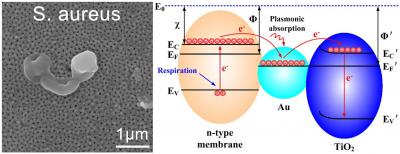Bringing the bling to antibacterials

This image depicts destructive electron extraction from bacterial membranes by plasmonic gold nanoparticles. Credit: Jinhua Li/SICCAS
Bacteria love to colonize surfaces inside your body, but they have a hard time getting past your rugged, salty skin. Surgeries to implant medical devices often give such bacteria the opportunity needed to gain entry into the body cavity, allowing the implants themselves to act then as an ideal growing surface for biofilms.
A group of researchers at the Shanghai Institute of Ceramics in the Chinese Academy of Sciences are looking to combat these dangerous sub-dermal infections by upgrading your new hip or kneecap in a fashion appreciated since ancient times – adding gold. They describe the results of tests with a new antibacterial material they developed based on gold nanoparticles in the journal Applied Physics Letters, from AIP Publishing.
“Implant-associated infections have become a stubborn issue that often causes surgery failure,” said Xuanyong Liu, the team's primary investigator at the Shanghai Institute of Ceramics. Designing implants that can kill bacteria while supporting bone growth, Liu said, is an efficient way to enhance in vivo osteointegration.
Titanium dioxide is able to kill bacteria itself due to its properties as a photocatalyst. When the metal is exposed to light, it becomes energetically excited by absorbing photons. This generates electron-hole pairs, turning titania into a potent electron acceptor that can destabilize cellular membrane processes by usurping their electron transport chain's terminal acceptor. The membrane is gradually destabilized by this thievery, causing the cell to leak out until it dies.
The dark conditions inside the human body, however, limit the bacteria-killing efficacy of titanium dioxide. Gold nanoparticles, though, can continue to act as anti-bacterial terminal electron acceptors under darkness, due to a phenomenon called localized surface plasmon resonance.
Surface plasmons are collective oscillations of electrons that occur at the interface between conductors and dielectrics – such as between gold and titanium dioxide. The localized electron oscillations at the nanoscale cause the gold nanoparticles to become excited and pass electrons to the titanium dioxide surface, thus allowing the particles to become electron acceptors.
Liu and his team electrochemically anodized titanium to form titanium dioxide nanotube arrays, and then further deposited the arrays with gold nanoparticles in a process called magnetron sputtering. The researchers then allowed Staphylococcus aureus and Escherichia coli to grow separately on the arrays — both organisms were highly unsuccessful, exhibiting profuse membrane damage and cell leakage.
While silver nanoparticles have been previously explored as an antibacterial agent for in vivo transplants, they cause significant side effects such as cytotoxicity and organ damage, whereas gold is far more chemically stable, and thus more biocompatible.
“The findings may open up new insights for the better designing of noble metal nanoparticles-based antibacterial applications,” Liu said.
Further research for Liu and his colleagues includes expanding the scope of experimental bacteria used and evaluating the arrays' in vivo efficacy in bone growth and integration.
The article, “Plasmonic gold nanoparticles modified titania nanotubes for antibacterial application” is authored by Jinhua Li, Huaijuan Zhou, Shi Qian, Ziwei Liu, Jingwei Feng, Ping Jin and Xuanyong Liu. It will appear in the journal Applied Physics Letters on July 1, 2014. After that date, it can be accessed at: http://scitation.aip.org/content/aip/journal/apl/104/26/10.1063/1.4885401
ABOUT THE JOURNAL
Applied Physics Letters features concise, rapid reports on significant new findings in applied physics. The journal covers new experimental and theoretical research on applications of physics phenomena related to all branches of science, engineering, and modern technology. See: http://apl.aip.org
Media Contact
More Information:
http://www.aip.orgAll latest news from the category: Physics and Astronomy
This area deals with the fundamental laws and building blocks of nature and how they interact, the properties and the behavior of matter, and research into space and time and their structures.
innovations-report provides in-depth reports and articles on subjects such as astrophysics, laser technologies, nuclear, quantum, particle and solid-state physics, nanotechnologies, planetary research and findings (Mars, Venus) and developments related to the Hubble Telescope.
Newest articles

Bringing bio-inspired robots to life
Nebraska researcher Eric Markvicka gets NSF CAREER Award to pursue manufacture of novel materials for soft robotics and stretchable electronics. Engineers are increasingly eager to develop robots that mimic the…

Bella moths use poison to attract mates
Scientists are closer to finding out how. Pyrrolizidine alkaloids are as bitter and toxic as they are hard to pronounce. They’re produced by several different types of plants and are…

AI tool creates ‘synthetic’ images of cells
…for enhanced microscopy analysis. Observing individual cells through microscopes can reveal a range of important cell biological phenomena that frequently play a role in human diseases, but the process of…





















